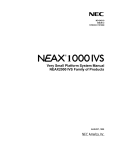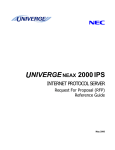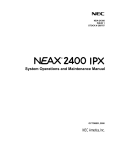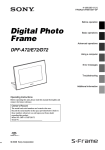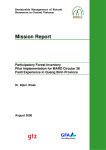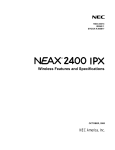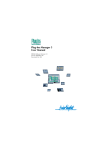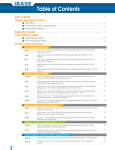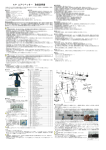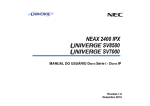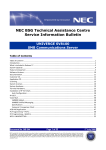Download NEC NEAX2000 ND-91649 User's Manual
Transcript
19 ND-91649 (E) ISSUE 3 General Description NEC Corporation LIABILITY DISCLAIMER NEC Corporation reserves the right to change the specifications, functions, or features, at any time, without notice. NEC Corporation has prepared this document for use by its employees and customers. The information contained herein is the property of NEC Corporation and shall not be reproduced without prior written approval from NEC Corporation. NEAX and Dterm are registered trademarks of NEC Corporation. Copyright 2004 NEC Corporation Printed in Japan. All other brand or product names are or may be trademarks or registered trademarks of, and are used to identify products or services of their respective owners. ND-91649(E) ISSUE 3 NEAX 2000 IPS General Description TABLE OF CONTENTS Page CHAPTER 1 INTRODUCTION ............................................................................................................. 1 System Overview ..................................................................................................................................................1 Hardware Architecture .........................................................................................................................................5 Software Architecture ..........................................................................................................................................7 CHAPTER 2 SYSTEM CONFIGURATION ........................................................................................ 10 Module Configuration.........................................................................................................................................10 Installation Methods ...........................................................................................................................................11 Modules and Installation Hardware ..................................................................................................................14 Circuit Cards .......................................................................................................................................................15 System Conditions .............................................................................................................................................15 CHAPTER 3 TERMINALS ................................................................................................................. 17 Desk Console ......................................................................................................................................................18 Figures of Dterm Series i/Dterm IP.........................................................................................................................22 Wireless System .................................................................................................................................................28 Dterm Softphone (SP30) .......................................................................................................................................37 CHAPTER 4 OVERVIEW OF INSTALLATION, PROGRAMMING, AND MAINTENANCE .............. 39 Installation...........................................................................................................................................................39 Programming ......................................................................................................................................................40 Maintenance ........................................................................................................................................................41 CHAPTER 5 SPECIFICATIONS ........................................................................................................ 42 System Capacity .................................................................................................................................................42 IP Specifications .................................................................................................................................................45 Line Conditions...................................................................................................................................................47 Cell Station/Zone Transceiver Line Conditions...............................................................................................48 Traffic Capacity...................................................................................................................................................49 DRS (Device Registration Server).....................................................................................................................49 ND-91649(E) TABLE OF CONTENTS Page i ND-91649(E) ISSUE 3 LIST OF ILLUSTRATIONS Figure Title Page Figure 1-1 NEAX 2000 IPS...................................................................................................................................1 Figure 1-2 NEAX 2000 IPS System Overview....................................................................................................2 Figure 1-3 Example of Network Configuration of Remote PIM over IP ..........................................................3 Figure 1-4 Retrofit MP/FP for Upgrading NEAX 7400 ICS M100 to IPS (Single MP System)........................4 Figure 1-5 Retrofit MP/FP for Upgrading NEAX 7400 ICS M100 to IPS (Dual MP System)...........................4 Figure 1-6 Trunking Diagram of NEAX 2000 IPS ..............................................................................................9 Figure 2-1 Module Configuration of NEAX 2000 IPS......................................................................................10 Figure 2-2 Face Layout of NEAX 2000 IPS ......................................................................................................11 Figure 2-3 Wall-mounting of PIM......................................................................................................................12 Figure 2-4 19-inch Rack-mounting...................................................................................................................13 Figure 3-1 DESK Console .................................................................................................................................18 Figure 3-2 Dterm 2 (White)...................................................................................................................................22 Figure 3-3 Dterm 8 (White)...................................................................................................................................22 Figure 3-4 Dterm 8D (White) ................................................................................................................................22 Figure 3-5 Dterm 16D (White) ..............................................................................................................................23 Figure 3-6 Dterm 32D (White) ..............................................................................................................................23 Figure 3-7 DSS Console (Black).......................................................................................................................23 Figure 3-8 Dterm 16LD (Black) ............................................................................................................................24 Figure 3-9 Analog Port Adapter (APR) ............................................................................................................24 Figure 3-10 Ancillary Device Adapter (ADA)...................................................................................................24 Figure 3-11 Computer Telephony Adapter (CTA)...........................................................................................25 Figure 3-12 IP Adapter (IPW) ............................................................................................................................25 Figure 3-13 System Configuration of Wireless Communications ................................................................29 Figure 3-14 Cell Station (CS), IP Base Station (IP-BS) and PHS Personal Station (PS) .............................33 Figure 3-15 Zone Transceiver (ZT) and PCS Personal Station (PS) .............................................................36 Figure 3-16 SP30 Screen...................................................................................................................................37 LIST OF ILLUSTRATIONS Page ii ND-91649(E) ND-91649(E) ISSUE 3 LIST OF TABLES Table Title Page Table 1-1 Technical Terms of NEAX 2000 IPS System ....................................................................................8 Table 2-1 Modules of NEAX 2000 IPS System ................................................................................................14 Table 3-1 Dterm Series i/Dterm IP Specifications and Accessories ..................................................................26 Table 3-2 Combination Pattern of Optional Accessories to the Dterm Series i/ Dterm IP...............................27 Table 3-3 PHS Personal Station (PS) Specifications .....................................................................................30 Table 3-4 2-Wired (U-Interface) Cell Station (CS) Specifications..................................................................31 Table 3-5 IP Base Station (IP-BS) Specifications ...........................................................................................32 Table 3-6 PCS Personal Station (PS) Specifications .....................................................................................34 Table 3-7 Zone Transceiver (ZT) Specifications.............................................................................................35 Table 5-1 System Capacity (Single MP System).............................................................................................42 Table 5-2 IP Specifications ...............................................................................................................................45 Table 5-3 Line Conditions .................................................................................................................................47 Table 5-4 Cell Station/Zone Transceiver Line Conditions .............................................................................48 Table 5-5 Traffic Capacity .................................................................................................................................49 Table 5-6 DRS (Device Registration Server)-System Based .........................................................................49 ND-91649(E) LIST OF TABLES Page iii INTRODUCTION CHAPTER 1 INTRODUCTION This document provides an overview of the NEAX 2000 IPS (Internet Protocol Server) stored program control digital electronic PBX. An introduction to the technical characteristics is included, along with a description of available system applications. System Overview The NEAX 2000 IPS is a full-featured IP-based communications system providing a rich feature set of NEAX 7400 ICS M100MX*, with pure Voice over IP (VoIP) communications (peer-to-peer connections), across corporate Local and Wide Area Networks (LAN and WAN). Figure 1-1 NEAX 2000 IPS The NEAX 2000 IPS supports both pure IP switching (peer-to-peer connections) and Time Division Switching. The pure IP switching is provided for communications between DtermIPs and for CCIS connections with another NEAX 2000 IPS/2400 IPX (CCIS over IP). On the other hand, the TDM switching is provided for communication between legacy stations/trunks. Connections between DtermIP/CCIS over IP and legacy stations/trunks are made via IP PADs, which converts packet-based voice data to TDM-based voice data, and vice versa. * “NEAX 7400 ICS M100MX” is marketed in North/Latin America and Australia as “NEAX 2000 IVS2” and in UK as “NEAX 2000 INTEGRATED VOICE SERVER.” ND-91649(E) CHAPTER 1 Page 1 INTRODUCTION DtermIP telephones are designed to provide a converged infrastructure at the desktop, with a 100 Base T Ethernet connection to the LAN and built-in hub for a PC connection to the telephone itself. The system can provide peer-to-peer connections between DtermIP telephones with voice compression, on a CCIS basis (CCIS over IP). PHS cell station can also be connected to LAN with 100 Base T Ethernet as IP-BS. IPS also provide Windows PC based softphone (Dterm Softphone SP30) to connect to LAN network and it provides IP enabled Dterm features without the telephone set. NEAX 2000 IPS Work Station Peer to Peer term D Softphone IP Switched MP MAT PS DHCP Server IP-BS Figure 1-2 NEAX 2000 IPS System Overview The NEAX 2000 IPS can also provide legacy station/trunk interfaces to support the existing Time Division Multiplexing (TDM) based infrastructure, such as analog telephones, analog networks, and digital networks (T1/E1, ISDN etc.). The legacy station/trunk interface cards (LT and AP cards) can be accommodated in the Port Interface Modules (PIM), in the same manner as the NEAX 7400 ICS M100MX*. At maximum configuration, total system capacity is 768 ports. The system can provide 512 ports for DtermIP telephones and legacy LT cards, and 256 ports for legacy AP cards. Communications between legacy station/trunks and DtermIP telephones/IP networks are made via IP PAD, which converts packet-based voice data to TDM-based voice data, and vice versa. Both peer-to-peer connections and TDM-based connections are controlled by a new Main Processor (MP) card. The new MP card incorporates a built-in Device Registration Server (DRS) and a single interface point of IP connections to IP telephone, MATWorX, and OAI/ACD servers. All Application Processor cards used in NEAX 7400 ICS M100MX* except AP01 and CC01 cards are available for the IPS system. All Business/Hotel/Data/CCIS/ISDN/WCS features are available. The following service features are now included on the MP card and do not require the AP01 card. Authorization Code with AP01 Forced Account Code with AP01 Direct Inward System Access (DISA) with AP01 (For North America)/Remote Access to System with AP01 (For other than North America) Call Forwarding set by DISA with AP01 * “NEAX 7400 ICS M100MX” is marketed in North/Latin America and Australia as “NEAX 2000 IVS2” and in UK as “NEAX 2000 INTEGRATED VOICE SERVER.” CHAPTER 1 Page 2 ND-91649(E) INTRODUCTION Remote PIM over IP NEAX 2000 IPS can install a PIM at remote site through IP network. At the main site, the NEAX 2000 IPS is installed and the Remote PIM is installed at remote site. The main site controls call processing and service feature access for station users located both main and remote sites. When the Remote PIM cannot be connected with the main site due to the IP network and/or main PBX failure, the Remote PIM initializes the system and re-starts operation by its own Main Processor (survival mode). In the survival mode, almost all service features are provided to the station users accommodated in Remote PIM. When IP network/main PBX is recovered, the Remote PIM can be restored to normal mode with system initialization by manual operation or automatically (Selectable by system data setting). Remote-1 PSTN Main PSTN LAN or WAN Remote-2 Remote-3 Note 1: Both legacy and IP stations/trunks can be accommodated in Remote PIM. Note 2: When the Remote PIM accommodates legacy trunk, the incoming/outgoing calls are connected to the station through local TDSW. Figure 1-3 Example of Network Configuration of Remote PIM over IP ND-91649(E) CHAPTER 1 Page 3 INTRODUCTION Migration Path For customers who are using the NEAX 7400 ICS M100MX*, the migration path is supplied. By replacing the existing MP card to the new IPS MP card, the NEAX 7400 ICS M100MX* can be upgraded to IP/TSW Hybrid System including new and enhanced service features introduced with the NEAX 2000 IPS. For customers who are using NEAX 7400 ICS M100*/M80VS, by replacing existing PN-CP00/CP03 with Retrofit MP and PN-CP01 with Retrofit FP, the NEAX 7400 ICS M100/M80VS can be upgraded to the NEAX 2000 IPS features. In case of NEAX 7400 ICS M100/M80VS Dual MP System the CP02 is replaced with CP28-A Retrofit Dual MP. (See the following figure showing replacement of control cards. As for the LT/AP card conditions after upgrading, refer to the “NEAX 2000 IPS Card Application List”.) NEAX 7400 ICS M100 before upgrading NEAX 7400 ICS M100 after upgrading BSU BSU BSU CP17 BSU CP01 BSU BSU Replace MP/FP MP: PN-CP00 to PN-CP26-A FP: PN-CP01 to PN-CP17 Remove FP0 (CP01) mounted in PIM0 BSU CP26 BSU CP00 CP01 Figure 1-4 Retrofit MP/FP for Upgrading NEAX 7400 ICS M100 to IPS (Single MP System) NEAX 7400 ICS M100 before upgrading NEAX 7400 ICS M100 after upgrading BSU BSU BSU BSU BSU BSU CP28 CP28 BSU CP02 CP02 CP01 17-TW-0.3 CONN CA-A CP17 BSU CP01 Replace MP/FP MP: PN-CP02 to PN-CP28-A FP: PN-CP01 to PN-CP17 Remove FP0 (CP01) mounted in PIM0 Figure 1-5 Retrofit MP/FP for Upgrading NEAX 7400 ICS M100 to IPS (Dual MP System) * “NEAX 7400 ICS M100MX” is marketed in North/Latin America and Australia as “NEAX 2000 IVS2” and in UK as “NEAX 2000 INTEGRATED VOICE SERVER.” * “NEAX 7400 ICS M100” is marketed in North America as “NEAX 2000 IVS” and in Australia as “NEAX ICS 120”. * “NEAX 7400 ICS M80VS” is marketed in Australia as “NEAX ICS 110”. CHAPTER 1 Page 4 ND-91649(E) INTRODUCTION Hardware Architecture Reduced Hardware with IP-based Architecture term The DtermIPs, D Softphone and IP-BS connected to the LAN do not require any special interface cards* because they can be interfaced directly with the LAN and connected with peer-to-peer basis. When the DtermIP, term D Softphone or IP-BS is connected to a station/trunk that is using TSW, the speech path between LAN and term TSW is made via IP PAD under the call processing control of the MP. The DtermIP, D Softphone or IP-BS can be expanded simply adding the terminal itself. With this system architecture, the hardware such as DLC, CSI, CSH, PIM, Power Supply etc. is reduced and easy moves, adds, and changes can be realized. Standard TDM Hardware Peer-to-Peer IP Hardware Line & Trunk Cards Application Processors Firmware Processors IP PAD (8IPLA, 24IPLA, 32IPLA, 16VCT) Ether Card (M606) Powerful, One-board Main Processor (MP) with Integrated Functionality The NEAX 2000 IPS Main Processor (MP) is the heart of pure IP connections and TDM-based connections. The MP employs a high-speed CPU, which is equivalent with Pentium. With this processing power and System On Chip (SOC) technology, the MP integrates Device Registration Server (DRS), AP01 (OAI) functions, which are provided by an additional card in the previous M100MX*. Also, by means of today’s advanced LSI technology, the MP card size is minimized and On-board Ethernet Interface card is mounted on the MP without using an additional slot space in the PIM. This interface card is linked with LAN for call control processing of DtermIP and inter-work with MATWorX and OAI server. Enhanced Built-in Firmware Processor (FP) on MP The NEAX 7400 ICS M100MX* requires the FP card in PIM0 when the system is configured with 3 or more PIMs. In case of the NEAX 2000 IPS, the FP in PIM0 is not required since the Built-in FP function in new MP has been improved and it provides more call processing capability. (FP is used in PIM2, 4 and 6.) * DLC, CSI and CS handler. ND-91649(E) CHAPTER 1 Page 5 INTRODUCTION Extended Application Processor (AP) Port Capacity The NEAX 2000 IPS provides a maximum of 256 AP ports and it is independent of the 512 ports for the Line/Trunk (LT), therefore, more AP cards such as T1/E1 digital link cards can be used in the system. Universal Slot One PIM provides 12 card slots for Line/Trunk (LT). Also, these card slots can be used for Application Processor (AP) cards without complicated limitation. This makes easy quotation and installation, and more AP cards can be mounted in one PIM. Unified Circuit Card Size All the circuit cards for the NEAX 2000 IPS are designed in one size (PN-type), and installed in the PIM. This maximizes the efficiency of slot utilization of the PIM. High Density Line/Trunk Cards The major line/trunk cards used in the NEAX 2000 IPS are provided with 8 circuits per card. This allows the physical system size to be compact. Various Power supply system AC Input system The PIM houses the AC/DC power supply with various AC (100V/200V) input that outputs various DC voltage required for several internal cards. The AC/DC power supply has function of Battery charger. Thus, system can be backed up with battery according to necessity. The PIM also houses optional DC/DC power supply for the cards that require -48V power such as CSI card used for interface of cell station/zone transceiver. DC Input system NEAX 2000 IPS also provides the DC/DC power supply with -48V DC input house in the PIM that outputs various DC voltage required for several internal cards. Thus, NEAX 2000 IPS can be installed at various powering environment. Various Installation Methods To meet the specific needs of the customer’s environment, the NEAX 2000 IPS provides the following installation methods: Floor Standing Installation Wall-mounting Installation IEC standard 19-inch Rack-mounting Installation CHAPTER 1 Page 6 ND-91649(E) INTRODUCTION Software Architecture Built-in DRS (Device Registration Server) on MP The NEAX 2000 IPS incorporates DRS (Device Registration Server) on the MP. DRS provides Log-in/Logout management of DtermIP including Registration and Authentication. Also, the built-in DRS can be interworked with DHCP server to provide easy administration on IP address. Office Data Backup Enhancement The office data of the NEAX 2000 IPS is stored in Flash ROM, therefore the backup period is extended compared with previous M100MX series which were using RAM with battery. * M100MX is marketed in North/Latin America and Australia as “NEAX 2000 IVS2” and in UK as “NEAX 2000 INTEGRATED VOICE SERVER.” ND-91649(E) CHAPTER 1 Page 7 INTRODUCTION Technical Terms Table 1-1 Technical Terms of NEAX 2000 IPS System SYMBOL DESCRIPTION SYMBOL DESCRIPTION AMP Amplifier Trunk Card LC Line Circuit Card (for Single Line Telephone) AP00 SMDR/Hotel Application Card LDT LD Trunk Card BGM External Music Source for Dterm Back Ground Music Service LLC Long Line Circuit Card BRT Basic Rate Interface Trunk Card M10 Optical Interface Card CCH Common Channel Handler Card MAT Maintenance Administration Terminal CFT 6/10 Party Conference Trunk Card MDF Main Distribution Frame CIS Call Information System MEM Main Memory CIR CALLER ID Receiver Trunk Card MFR MF Receiver/ MFC Receiver/Sender Card COT C.O. Trunk Card MLDT Melody Trunk CSI CS/ZT Interface Card MODEM Modem CS/ZT Cell Station (For Australia/Others) Zone Transceiver (For North America/ Latin America) MP Main Processor Card DAT Digital Announcement Trunk Card PFT Power Failure Transfer DCH D-channel Handler Card PMS Property Management System DIT DID Trunk Card OAI Open Application Interface DK External Relay/Key Interface Card ODT OD Trunk Card (2/4 wire E&M) DLC Digital Line Circuit Card (for Dterm, ATTCON, DESKCON) PBR PB Receiver Card DSS DSS Console PBSND PB Sender DTI Digital Trunk Interface Card PLO Phase Locked Oscillator DTG Digital Tone Generator PS Personal Station ETHER Ethernet Control Card PRT ISDN Primary Rate Interface Trunk Card ICH ISDN-channel Handler Card SMDR Station Message Detail Recording ILC ISDN Line Circuit Card TDSW Time Division Switch IP-BS IP Base Station TNT Tone/Music Source Interface Card IP PAD IP Packet Assembler/Disassembler Card VCT CODEC Card IPT IP Trunk Card VM Voice Mail Card KEY External Key 16CFT 16-Circuit Four-Party Conference Trunk CHAPTER 1 Page 8 ND-91649(E) INTRODUCTION Trunking Diagram This figure shows a typical trunking diagram of the NEAX 2000 IPS system. Figure 1-6 Trunking Diagram of NEAX 2000 IPS ND-91649(E) CHAPTER 1 Page 9 SYSTEM CONFIGURATION CHAPTER 2 SYSTEM CONFIGURATION Module Configuration The NEAX 2000 IPS consists of Port Interface Modules (PIM) depending on the system configuration, and there are two types of PIMs; “Physical” PIM and “Virtual” PIM. The Physical PIM is a “hardware” PIM and is used to accommodate an MP, FPs, IP PADs, legacy LT an AP cards, and power supply units. One Physical PIM provides up to 64 ports. The Virtual PIM is a “software” PIM and is used to assign DtermIP telephones, Dterm SP30 or IP-BS by system programming. One Virtual PIM provides up to 64 DtermIP telephones. The system consists of up to 8 PIMs, by the combination of Physical PIMs and Virtual PIMs, thus providing 448 ports for Dterm IP telephones and 512 ports for legacy LT cards. The total number of ports for DtermIP telephones and legacy LT cards must be 512 or fewer, so that the number of Physical PIMs decreases when that of Virtual PIMs (= number of DtermIP telephones) increases. For example, when 256 legacy LT ports are required (= four Physical PIMs), the maximum number of Dterm IPs is 256. The figure below shows examples of 512-port configuration by combination of legacy LT ports and Dterm IP telephones. PIM #3 PIM #2 PIM #1 PIM #0 PIM #7 PIM #6 PIM #5 PIM #4 PIM #3 PIM #2 PIM #1 PIM #0 PIM #7 PIM #6 PIM #5 PIM #4 PIM #3 PIM #2 PIM #1 PIM #0 PIM #7 PIM #6 PIM #5 PIM #4 PIM #3 PIM #2 PIM #1 PIM #0 PIM #7 PIM #6 PIM #5 PIM #4 64 LT ports + 448 Dterm IPs 128 LT ports + 384 Dterm IPs 192 LT ports + 256 Dterm IPs 256 LT ports +256 Dterm IPs PIM #3 PIM #2 PIM #1 PIM #0 PIM #3 PIM #2 PIM #1 PIM #0 PIM #3 PIM #2 PIM #1 PIM #0 PIM #3 PIM #2 PIM #1 PIM #0 PIM #7 PIM #6 PIM #5 PIM #4 PIM #7 PIM #6 PIM #5 PIM #4 320 LT ports + 128 Dterm IPs 384 LT ports + 128 Dterm IPs PIM PIM Physical PIM Virtual PIM Figure 2-1 CHAPTER 2 Page 10 PIM #7 PIM #6 PIM #5 PIM #4 448 LT ports + 0 Dterm IPs 512 LT ports + 0 Dterm IPs Module Configuration of NEAX 2000 IPS ND-91649(E) PIM #7 PIM #6 PIM #5 PIM #4 SYSTEM CONFIGURATION Installation Methods The NEAX 2000 IPS provides three installation methods as follows: Floor Standing Installation Wall Mounting Installation 19-inch Rack Mounting Installation Floor Standing Installation In Floor Standing Installation, the NEAX 2000 IPS is comprised of up to 8 Port Interface Modules (PIMs). PIM #3 PIM #2 PIM #2 PIM #1 PIM #1 PIM #1 PIM #0 PIM #0 PIM #0 PIM #0 BASE BASE BASE BASE (64 ports) (128 ports) (192 ports) (256 ports) PIM #3 PIM #3 PIM #3 PIM #3 PIM #7 PIM #2 PIM #2 PIM #2 PIM #6 PIM #2 PIM #6 PIM #1 PIM #1 PIM #5 PIM #1 PIM #5 PIM #1 PIM #5 PIM #0 PIM #4 PIM #0 PIM #4 PIM #0 PIM #4 PIM #0 PIM #4 BASE BASE BASE BASE BASE BASE BASE BASE (320 ports) (384 ports) Figure 2-2 (448 ports) (512 ports) Face Layout of NEAX 2000 IPS ND-91649(E) CHAPTER 2 Page 11 SYSTEM CONFIGURATION Wall-mounting Installation The NEAX 2000 IPS can be wall-mounted with single or multiple PIM (MAX. 8) configuration. Figure 2-3 CHAPTER 2 Page 12 Wall-mounting of PIM ND-91649(E) SYSTEM CONFIGURATION 19-inch Rack-mounting Installation The NEAX 2000 IPS can be mounted in the IEC-standard 19-inch rack up to 4 PIMs. (IEC: International Electro-technical Commission) 19” BRACKET(A) 19” BRACKET(B) Figure 2-4 19-inch Rack-mounting ND-91649(E) CHAPTER 2 Page 13 SYSTEM CONFIGURATION Modules and Installation Hardware The NEAX 2000 IPS is comprised of up to 8 Port Interface Modules (PIMs). Modules (1) Port Interface Module (PIM) A PIM provides 13 card slots for common control, Line/Trunk (LT), and Application Processor (AP) cards. It also houses an AC/DC Power Supply (or DC/DC Power Supply), optional DC/DC Power Supply (for -48V), and batteries for protection from short-term (about 30 min.) power interruption. Four champ connectors for Line/Trunk (LTC 0 to 3) are located at the lower front side of the PIM. A PIM provides a maximum of 12 card slots for Line/Trunk (LT) and Application Processor (AP) cards. At maximum configuration, the system is comprised of 8 PIMs. PIM MD PIM MD (PIM3) (PIM7) PIM MD PIM MD (PIM2) (PIM6) PIM MD PIM MD (PIM1) (PIM5) PIM MD PIM MD (PIM0) (PIM4) Single MP System PIM MD PIM MD (PIM3) (PIM7) PIM MD PIM MD (PIM2) (PIM6) PIM MD PIM MD (PIM1) (PIM5) PIM MF PIM MD (PIM4) (PIM0) Dual MP System (2) Battery Module (BATTM)* The BATTM is an optional module for installing optional long-term (about 3 hours) backup batteries. The BATTM is designed to accommodate batteries covering up to a 4-PIM system (2 BATTMs support maximum system configuration). The BATTM is available for Floor Standing Installation. (When the system is Wall-mounting/19-inch Rack-mounting configuration, the BATTM cannot be installed with the PIM.) Table 2-1 Abbrev PIMMD PIM MF BATTM Modules of NEAX 2000 IPS System Name Code SN1617 PIMMD SN1658 PIMMF SN1619 BATTMB Remarks PIM 0 ~ PIM 7 PIM0 for dual MP system 1/STACK, Max.2/system * Battery Module is available for Latin America. CHAPTER 2 Page 14 ND-91649(E) SYSTEM CONFIGURATION Circuit Cards The circuit cards used for NEAX 2000 IPS are divided into the following three types. According to these card types, the mounting location of card and port allocation of the Time Division Switch are varied. Common Control Cards - Main Processor (MP) - Firmware Processor (FP) Line/Trunk (LT) Cards - IP PAD, Line Circuit (LC), Central Office Trunk (COT), Tie Line Trunk (LDT/ODT), etc. Application Processor (AP) Cards - SMDR/PMS/CIS/Hotel Printer Interface (AP00) - T1/E1 Digital Trunk Interface (DTI) System Conditions Conditions for Peer-to-Peer Connection For the communication between Dterm IPs, the voice data is transmitted and received directly, without converting voice packets into PCM and voice compression in the system. Conditions for CCIS Connection Dterm IP to Dterm IP connection (Peer-to-Peer connection) via CCIS is available only when the destination office uses NEAX 2000 IPS or NEAX 2400 IPX. The built-in CCH-IPT of MP card can be connected to max. 127 trunks. The system provides only Point-to-Multipoint connection. Conditions for H.323 Connection When connecting to the IP network with H.323 protocol, the IPT card is required. When connecting to the IP network with H.323 protocol, the voice data is transmitted and received via the IP-PAD card. Conditions for Legacy Interface (LT/AP) All Application Processor cards used in NEAX 7400 ICS M100MX* except AP01 and CC01 cards are available for the system. All Line/Trunk cards used in NEAX 7400 ICS M100MX* are available for the system. * “NEAX 7400 ICS M100MX” is marketed in North/Latin America and Australia as “NEAX 2000 IVS2” and in UK as “NEAX 2000 INTEGRATED VOICE SERVER.” ND-91649(E) CHAPTER 2 Page 15 SYSTEM CONFIGURATION Conditions for Maintenance MATWorX can be used as the maintenance program for NEAX 2000 IPS. Direct connection (RS-232C), Modem connection and LAN (TCP/IP) connection are available to connect to the MAT (Maintenance Administration Terminal). Conditions for DRS DRS = Device Registration Server The Dterm IP registration is executed by the DRS-System Based. for the Dterm IP registration. The DRS can be used as the Proxy server. CHAPTER 2 Page 16 ND-91649(E) The DRS-Network Based is not available TERMINALS CHAPTER 3 TERMINALS A variety of terminal equipment may be connected to the NEAX 2000 IPS. The following equipment may be installed with the system. Attendant Console Desk Console Dterm Series i Dterm 2 (White/Black Color) Dterm 8 (White/Black Color) Dterm 8D (White/Black Color) Dterm 16D (White/Black Color) Dterm 32D (White/Black Color) Dterm 16 LD (White/Black Color) : : : : : : 2-button terminal 8-button terminal 8-button terminal with LCD display 16-button terminal with LCD display 32-button terminal with LCD display 16-button LD terminal with LCD display Dterm IP Dterm 8D (White/Black Color) Dterm 16D (White/Black Color) : : 8-button terminal with LCD display 16-button terminal with LCD display PS (Wireless Handset) PHS model PCS model Dterm SP30 (or Dterm SP20) (IP Softphone) ND-91649(E) CHAPTER 3 Page 17 TERMINALS Desk Console The SN716 Desk Console has an ergonomic design and provides full access to all PBX Console features. It connects to the NEAX 2000 IPS using the same circuit cards as the Dterm 75 Series terminals. The SN716 Desk Console operates on a switched-loop basis with a maximum of 6 Attendant loops terminating at each console on the associated Interface card. The Attendant uses these loops for answering, originating, holding, extending, and reentering calls. When Attendant loop release is used, the number of loops is effectively increased to a maximum of 12 for each console. The NEAX 2000 IPS supports a maximum of eight SN716 DESK Consoles. SN716 DESKCON Features • Character LCD (4x40 characters) • LCD designation strips • Software-controlled LCD loop key • Full access to PBX features • Headset connectivity • Recorder connectivity Figure 3-1 DESK Console CHAPTER 3 Page 18 ND-91649(E) TERMINALS Dterm Series i/Dterm IP Digital Multifunction Terminals The Dterm Series digital multifunction/multiline terminal is available in two colors to meet the needs of various users based on the features and types of communications each end user requires. Dterm Series i Dterm 2 (White/Black Color) Dterm 8 (White/Black Color) Dterm 8D (White/Black Color) Dterm 16D (White/Black Color) Dterm 32D (White/Black Color) Dterm 16LD (White/Black Color) term D IP Dterm 8D (White/Black Color) Dterm 16D (White/Black Color) : : : : : : 2-button terminal 8-button terminal 8-button terminal with LCD display 16-button terminal with LCD display 32-button terminal with LCD display 16-button LD terminal with LCD display : : 8-button terminal with LCD display 16-button terminal with LCD display Features most commonly used in daily operation and functions required by the user are provided by the following dedicated buttons/lamp. Hold - Press key to place an internal or external call on hold. TRANSFER - Allows the station user to transfer established calls to another station without attendant assistance. ANSWER - When LED on this key is lighted, press key to answer a waiting call. SPEAKER - Controls the built-in speaker that can be used for Hands Free Dialing/Monitoring and Voice Call. REDIAL - Press key to activate the redial feature, then press redial and scroll back through numbers that have been dialed. When desired number is displayed, press the key to activate dialing. CONF - Press key to establish a three-way conversation. RECALL - Press key to terminate established call and returns to the internal dial tone. FEATURE - Used to activate terminal setup functions and to program One-Touch Speed Dial/Feature Keys. DIRECTORY - Press key to activate speed calling. MESSAGE - Press key to access the voice mail system. MIC - Press key to respond hands free. LED on this key lights during speakerphone operation. This ergonomically designed terminal provides; larger keypad buttons for dialing convenience, an expanded three-line by 24-character LCD display, tiltable legs with nonskid feet, and a highly visible call/message indicator lamp. All models have built-in hands-free unit as standard. The terminal is connected to the NEAX 2000 IPS via a single pair of cabling, thus optimizing existing cabling environment. These advantages make the Dterm Series i terminals the standard for telephones that effectively meet today's business requirements. ND-91649(E) CHAPTER 3 Page 19 TERMINALS Dterm Series i/Dterm IP Lineup Dterm 2 (2-button Dterm) This Dterm Series Digital Multi-line Terminal is equipped with 8 dedicated Function keys (such as Hold, TRANSFER, ANSWER, SPEAKER, REDIAL, CONF, RECALL and FEATURE), 2 programmable Line/Feature keys (each with a two-color LED). 2 programmable keys are flexible and can be assigned to any outside line connected to the system, to another station line, or as a feature button. The terminal is available in two colors - Black (BK) and Ivory White (WH). Dterm 8 (8-button Dterm) This Dterm Series Digital Multi-line Terminal is fully modular with 11 dedicated Function keys, 8 programmable Line/Feature keys (each with a two-color LED), built-in Speakerphone, built-in Headset Jack, Tone/Volume/Contrast control, Tilt Stand, and a large LED to indicate incoming calls and messages. The terminal is available in tow colors - Black (BK) and Ivory White (WH). Dterm 8D (8-button Dterm with Display) This Dterm Series Digital Multi-Line Terminal is equipped with 11 dedicated Function keys, 8 programmable Line/Feature keys (each with a two-color LED), built-in Speakerphone, built-in Headset Jack, Tone/Volume/Contrast control, Tilt Stand, 3 line by 24-character LCD Display Panel (adjustable & detachable), four Soft Keys, and a Large LED to indicate incoming calls and messages. This terminal is available in two colors - Black (BK) and Ivory White (WH). Dterm 16D (16-button Dterm with Display) This Dterm Series Digital Multi-Line Terminal is equipped with 11 dedicated Function keys, 16 programmable Line/Feature keys (each with a two-color LED), built-in Speakerphone, built-in Headset Jack, Tone/Volume/Contrast control, Tilt Stand, 3 line by 24-character LCD Display Panel (adjustable & detachable), four Soft Keys, and a Large LED to indicate incoming calls and messages. This terminal is available in two colors - Black (BK) and Ivory White (WH). Dterm 32D (32-button Dterm with Display) This Dterm Series Digital Multi-Line Terminal is equipped with 11 dedicated Function keys, 32 programmable Line/Feature keys (each with a two-color LED), built-in Speakerphone, built-in Headset Jack, Tone/Volume/Contrast control, Tilt Stand, 3 line by 24-character LCD Display Panel (adjustable & detachable), four Soft Keys, and a Large LED to indicate incoming calls and messages. Dterm 16LD (DESI Less 16 LD button Dterm with Display) This Dterm Series Digital Multi-Line Terminal is equipped with 11 dedicated Function keys, 16 programmable Line/Feature keys (each with a two-color LED), built-in Speakerphone, built-in Headset Jack, Tone/Volume/Contrast control, Tilt Stand, 3 line by 24-character LCD Display Panel (adjustable & detachable), four Soft Keys, and a Large LED to indicate incoming calls and messages. This terminal is available in two colors - Black (BK) and Ivory White (WH). CHAPTER 3 Page 20 ND-91649(E) TERMINALS Dterm Series i/Dterm IP Accessories Direct Station Selection (DSS) Console This Console is equipped with 60 programmable line keys (each with a two-color LED). These keys can be programmed as Direct Station keys, Function keys, or Line keys. The DCU-60 Console is available in two colors - Black (BK) and Ivory White (WH). Analog Port Adapter (APR) The Analog Port Adapter with Ringing (APR-U) provides an interface for installing single line telephones (SLTs), modems*. By installing the APR-U, calls may be initiated via a PC modem and switched to voice operation if desired. Data calls at a maximum speed of 28.8 kbps are also supported through the APR-U. The APR-U also has the added benefit of detecting incoming ringing signals. By providing ring detection, the user may wish to install a personal fax machine or an answering machine at the workstation and connect them through the Dterm Series instrument for convenience. * When a modem is installed to the Dterm Series Multi-line terminal with the APR-U, the modem and the Dterm Series Multi-line Terminal (handset, speakerphone, headset) cannot be used simultaneously. Ancillary Device Adapter (ADA) The Ancillary Device Adapter (ADA-U) allows for a direct connection from the Dterm Series i/ Dterm IP terminal to a tape recorder for logging/recording telephone calls. A dedicated set of input connectors is also provided for a recording tone unit to inform the parties that the call is being recorded. The ADA-U does not require an AC adapter. Computer Telephony Adapter (CTA) The Computer Telephony Adapter (CTA) provides Dterm with a connection to desktop PC, allowing users to operate Windows®-based Computer Telephony application such as ClientPhone 32. IP Adapter (IPW) The IP Adapter Unit (IPW) provides two 10/100 Base-T Ethernet ports to the Local Area Network (LAN) and a built-in switching hub for a PC connection to the adapter itself. Operating power can be fed by either an AC/DC adapter unit or a power patch panel connected to the LAN switch/hub. When the IPW is attached to the Dterm, other optional accessories cannot be attached except for Ancillary Device Adapter (ADA). Wall Mount Unit (WMU) The Wall Mount Unit (WMU) allows the Dterm Series terminal to be conveniently mounted vertically when desk space is not available. ND-91649(E) CHAPTER 3 Page 21 TERMINALS Figures of Dterm Series i/Dterm IP * Dterm 2 (Black) is also supported. * Dterm 8 (Black) is also supported. * Dterm 8 D(Black) is also supported. CHAPTER 3 Page 22 Figure 3-2 Dterm 2 (White) Figure 3-3 Dterm 8 (White) Figure 3-4 Dterm 8D (White) ND-91649(E) TERMINALS * Dterm 16 D (Black) is also supported. * Dterm 32 D (Black) is also supported. Figure 3-5 Dterm 16D (White) Figure 3-6 Dterm 32D (White) * DSS Console (White) is also supported. Figure 3-7 DSS Console (Black) ND-91649(E) CHAPTER 3 Page 23 TERMINALS * Dterm 16LD (White) is also supported. Figure 3-8 Dterm 16LD (Black) Figure 3-9 Analog Port Adapter (APR) Figure 3-10 Ancillary Device Adapter (ADA) CHAPTER 3 Page 24 ND-91649(E) TERMINALS Figure 3-11 Computer Telephony Adapter (CTA) Figure 3-12 IP Adapter (IPW) ND-91649(E) CHAPTER 3 Page 25 TERMINALS Dterm Series i/Dterm IP Specifications The specifications of the Dterm Series i/Dterm IP are shown in below. Table 3-1 Dterm Series i/Dterm IP Specifications and Accessories Specifications/Description Dedicated Function Keys Line/Feature Access/Programmable Feature Access Key LCD Dterm 8D D 2 D 8 D Dterm Series i IP 8 11 11 term 2 term Dterm 32D Dterm 16LD 11 11 32 16 3 Lines 24 Characters 8 16 None None 3 Lines 24 Characters 3 Lines 24 Characters - - LED (Green /Red) LED (Green /Red) LED (Green /Red) LED (Green /Red) 3 Lines 24 Charac - ters LED (Green /Red) Yes Yes Yes - Yes - Yes Yes Yes Yes Yes Yes Yes Optional Yes No Yes Yes Yes Yes Yes Yes Yes Yes Yes Yes Yes Yes Yes Yes Yes Yes Yes Yes Yes Yes Yes Yes Yes Yes Yes Yes Yes Yes Yes - - Yes Yes Yes Yes White or Black No White or Black No White or Black White or Black Yes Yes Soft Keys Optional Accessories DSS/BLF console* No Ancillary Device Adapter No (ADA-U) Analog Port Adapter w/ Ringing No (APR-U) PC Telephony Adapter (CTA)* No IP Adapter (IPW)* No * It requires an AC/DC adapter. ** Displayed characters are Only English. CHAPTER 3 Page 26 Dterm 16D D Dterm Series i IP 11 term 8 Indication on Line/Feature Keys Hands Free Operation: Half Duplex Call/Message Indicator Adjustable Legs (Built-in WMU) Volume Control Handset (Receiver) Volume Control Speakerphone (Receiver) Volume Control Handset (Receiver) Ring Volume Control Brightness Control-LCD Contrast Housing Color term White or Black Yes LCD** Icon White or Black Yes Yes Yes No Yes No Yes Yes Yes Yes No Yes No Yes Yes Yes Yes No Yes No Yes Yes Yes No Yes Yes No No Yes Yes No No Yes Yes Yes Yes ND-91649(E) TERMINALS Table 3-2 Combination Pattern of Optional Accessories to the Dterm Series i/ Dterm IP Combination Pattern 1 2 3 4 5 6 7 8 9 10 X : Available APR ADA X CTA IPW X X X X X X X X ND-91649(E) X X X WMU X X X X X X X X X X CHAPTER 3 Page 27 TERMINALS Wireless System A mobile work force no longer has to be dependent on special technology. With personal telephone and Wireless Communication System, employees can travel throughout a multistored building or across a large industrial complex and continue to stay in constant touch with customers and colleagues. NEAX 2400 IPX has built-in wireless system for providing wireless communication, it can support up to 256 users. Versatile Communication Tool for a variety of industries (1) Business Offices Even when an employee in the company cannot be reached at their desk, the wireless communication service can put them in touch immediately. A call from a customer can be connected directly to the called employee without holding the call or asking the customer to call back. This means improved customer satisfaction. Even when a company has offices in several different buildings, just install the connection unit, then all you have to do is carry the handy phone set to place or receive calls anywhere. Since the wireless communication service does not require reinstallation of equipment or re-registration of extension numbers whenever you change the office layout, it can effectively reduce costs. (2) Medical Centers (or Hospitals) By assigning a personal handy phone to each doctor and nurse, they can be reached anywhere in the hospital for faster response to emergencies. Better service can be offered to in-patients as well as patients with walking disabilities by lending them handy phone sets. Speedier communications is an extra touch that will make the patients reassured that they are in good hands. (3) Plants The wireless communication service allows bi-directional communications in large working areas such as plants, warehouses, and factories. Instructions and messages from the office or reports from the plant can be conveyed in real-time to help improve productivity. The wireless service also makes it possible to verify the process while moving over a line or to check the inventory in the warehouse with someone in the office over the telephone. Use the optional headset for hands-free communications without work interruptions for better safety and work efficiency. CHAPTER 3 Page 28 ND-91649(E) TERMINALS (4) Department Stores and Hotels On the sales floor, the wireless communication service allows a clerk to check inventory for a customer or promptly call the manager. When holding an even or exhibition, or when changing the sales floor layout, the wireless service requires no cable laying or transfer, so telephone installation and removal are simple. At hotels and resorts, the wireless communication service can be used between the front desk and the rest of the complex and for communications and instructions between staff members of an event in the complex. Assign each security guard a handy phone set, and you can realize more systematic reporting and higher mobility, as well as higher security in the event of an emergency. System Configuration Figure 3-13 shows the system configuration of NEAX 2000 IPX wireless communications system. Figure 3-13 System Configuration of Wireless Communications The wireless communications function conforms to the ARIB standard version 2 RCR STD-28 standarized in Japan as the PHS (Personal Handyphone System) or TIA/EIA-667 PACS WUPE standarized in USA as the unlicensed PCS (Personal Communications System) in accordance with market’s regulations. The PS (Personal Station), BS/ZT (Base Station/Zone Transceiver), IP-BS (IP Base Station) and the NEAX 2000 IPS provide wireless communications service on the private use. ND-91649(E) CHAPTER 3 Page 29 TERMINALS Personal Handyphone System (PHS) Personal Station (PS) The PS (Personal Station) incorporates the 32 Kbps ADPCM encoding technique and privacy function so that you can talk about even important matters in a noise-free, very clear voice. Since the PS is light-weight and compact in size, it can conveniently carried around. Here are specifications for the PS and its major functions. Specification of Personal Station Table 3-3 PHS Personal Station (PS) Specifications Item Frequency RF Power Voice Coding/Decoding System Basic Specifications Continuous Talk Time Continuous Standby Time Waterproof Dimensions Volume Weight Specifications 1.895 ~ 1.918 GHz 10mW (Average) 32 Kbps ADPCM Compliance with ARIB Standard RCR STD-28 version 2 Approx. 6 Hours Approx. 500 Hours Supported Approx. 40 (W) × 24 (D) × 130 (H) mm (Excluding Antenna) Approx. 105 cc Approx. 115 g Feature << Display/Indication >> 24-Digits Capacity (for Dialing and Storage) 11-Characters × 2-Lines Large Display + Indicator Battery Indicator Receiving Signal Strength Indicator Own Telephone Number Display Out of Area Indicator Softkey Display 2-Line Operation (L1 & L2) << Calling >> Incoming Call Indicator DTMF Dialing Vibrator Alert Automatic Answer << Memory >> Directory Dial (100 numbers with name) Speed Dial (20 numbers with name) Last Number Redial (10 numbers) Calling Party Number (10 numbers) Scrolling by Name on Memory Location << General >> Back Lighting Low Battery Alarm Volume Control (ringing tone, earpierce) Voice Mail Indication (VMI) Lock Function Name Display CHAPTER 3 Page 30 ND-91649(E) TERMINALS Cell Station (CS) Because of its small size, light weight and slenderness, the CS can be installed anywhere...the wall surface, the ceiling or behind the ceiling. In addition, its expansion or relocation can be smoothly performed. Followings are the specifications for the CS. Specification of Cell Station Table 3-4 2-Wired (U-Interface) Cell Station (CS) Specifications Item Specifications Radio Interface RCR STD-28 Ver. 2 (RF Power : 10mW Average) PBX Interface 2-Wire (metallic) Maximum Simultaneous Access per CS 3 Personal Stations Volume Approx. 700 cc Size Approx. 141 (W) × 183 (D) × 36 (H) mm (Excluding Antenna) Weight Approx. 380 g Power Supply PBX Power Supply (DC-48V) Local Power Supply (AC 100V/200V) Application In Door Type * This CS can download new soft program from MAT, so it can easily maintenance and operation. ND-91649(E) CHAPTER 3 Page 31 TERMINALS IP Base Station (IP-BS) PHS Base Station is installed on the IP network and LAN, and Wireless Communication System can be built. Management such as wiring can be reduced by IP-ization. Specification of IP Base Station Table 3-5 IP Base Station (IP-BS) Specifications Item Wire Interface Wireless Interface Number of Simultaneous calls Operating environment Power consumption Voice codec Dimensions Power Supply Specifications 10M/100M RJ45 Connecter 1port RCR STD-28 3rd edition 3CH 0-40 degree, 7W G.711, G.729a, G.723.1 160 × 159 × 40mm (w/o an antenna) Local power supply:AC-R UNIT Central power supply: Correspond to electric supply HUB SN8051 POESWEA-A(NEC) Catalyst 3550-24 PWR (Cisco) Catalyst Inline Power Patch Panel (Cisco) * This IP-BS can download new soft program from MAT, so it can easily maintenance and operation. CHAPTER 3 Page 32 ND-91649(E) TERMINALS 2-Wired Cell Station (CS) (U-Interface) IP-BS (TCP/IP or Ether) Personal Station (PS) Figure 3-14 Cell Station (CS), IP Base Station (IP-BS) and PHS Personal Station (PS) ND-91649(E) CHAPTER 3 Page 33 TERMINALS Personal Communication System (PCS) Personal Station (PS) The PS (Personal Station) incorporates the 32 Kbps ADPCM encoding technique and privacy function so that you can talk about even important matters in a noise-free, very clear voice. Since the PS is light-weight and compact in size, it can conveniently carried around. Here are specifications for the PS and its major functions. Specification of Personal Station Table 3-6 PCS Personal Station (PS) Specifications Item Frequency RF Power Voice Coding/Decoding System Basic Specifications Continuous Talk Time Continuous Standby Time Waterproof Dimensions Volume Weight Specifications 1.920 ~ 1.930 GHz 6.8 mW (Average) 32 Kbps ADPCM Compliance with TIA/EIA-667 PACS WUPE Approx. 6 Hours Approx. 500 Hours Supported Approx. 40 (W) × 24 (D) × 130 (H) mm (Excluding Antenna) Approx. 105 cc Approx. 115 g Feature << Display/Indication >> 24-Digits Capacity (for Dialing and Storage) 11-Characters × 2-Lines Large Display + Indicator Battery Indicator Receiving Signal Strength Indicator Own Telephone Number Display Out of Area Indicator Voice mail indication Softkey Display 2-Line Operation (L1 & L2) << Calling >> Incoming Call Indicator DTMF Dialing Vibrator Alert Automatic Answer << Memory >> Directory Dial (100 numbers with name) Speed Dial (20 numbers with name) Last Number Redial (5 numbers) Calling Party Number (5 numbers) Scrolling by Name on Memory Location << General >> Back Lighting Low Battery Alarm Volume Control (ringing tone, earpierce) Lock Function Voice Mail Indication (VMI) Wireless roaming Name Display CHAPTER 3 Page 34 ND-91649(E) TERMINALS Zone Transceiver (ZT) Because of its small size, light weight and slenderness, the ZT can be installed anywhere...the wall surface, the ceiling or behind the ceiling. In addition, its expansion or relocation can be smoothly performed. Followings are the specifications for the ZT. Specification of Zone Transceiver (ZT) Table 3-7 Zone Transceiver (ZT) Specifications Item Radio Interface PBX Interface Maximum Simultaneous Access per ZT Volume Size Weight Power Supply Application Specifications 2 Wire Zone Tranceiver (U-I/F) TIA/EIA-667 PACS WUPE (RF Power : 6.8mW Average) 2-Wire (metallic) 3 Personal Stations Approx. 560 cc Approx. 160 (W) × 139 (D) × 40 (H)mm (Excluding Antenna) Approx. 400 g PBX Power Supply (DC-48V) Local Power Supply (AC 100V/200V) In Door Type/Outdoor Box (Option) ND-91649(E) CHAPTER 3 Page 35 TERMINALS 2-Wired Zone Transceiver (ZT) (U-Interface) Personal Station (PS) Figure 3-15 Zone Transceiver (ZT) and PCS Personal Station (PS) CHAPTER 3 Page 36 ND-91649(E) TERMINALS Dterm Softphone (SP30) This Dterm Softphone provides the IP-enabled Dterm features without the telephone set, and it works on the Windows PC connected to LAN network. You click the button on the picture, the button, lamp and LCD works like an actual telephone. In addition to making and answering calls operation, Dterm SP30 provides call logs for all incoming and outgoing calls the user has made or received, and a recording of live conversation. Dterm SP30 also provides telephone directory integration. Users can dial one of four ways: Manual entry Drag and Drop numbers displayed in the contact book within MS Outlook Copy and Paste numbers displayed in Excel and/or the contact book within MS Outlook Using any PC telephony directory which can be linked via the API (DDE) interface of the Dterm SP30 Softphone Call button Logo button Task tray change button Compact mode change button Message waiting lamp Display 24 × 2 lines (LCD) Information window Function key button Transfer button Short message button Conference button Address book button Call log button Hold button Application sharing button Video conference button Function/Line button Call forwarding set button Member button 1&2 Volume control button Configuration button Video Mute button 10-key pad button Figure 3-16 SP30 Screen ND-91649(E) CHAPTER 3 Page 37 TERMINALS Subpanels and Functions Function Key Panel Displays lines and functions set for PBX and enables changing of button name and pop-up. Short Message Log Panel Displays transmission, reception and error logs of simple messages and lets user select a log to telephone or reply to a sender. Call Forward Settings Panel For setting or cancelling Call Forwarding-All Calls/Busy Line/ Don’t Answer/ Log Out for PBX. Call Log Panel A user can see origination and termination types, times, telephone numbers, conversation times, and speech memos; then save them in CSV-format file. Select a log for origination/termination, speech memo input, or deletion. Configuration Panel For setting origination rules, termination actions, voices, video conference actions, simple message actions, the number of logs, user names, automatic log in, and other convenient functions. Video Conference Panel Using cameras in conjunction with this panel, you can see video of calling party in the upper panel and yourself in the lower panel. Application Sharing Panel For application sharing and white board functions. 10-Key Keypad Panel Can be used like the dial pad of a telephone. Requirements Operating Environment PC OS Memory PCU HDD Audio device PBX-compatible IBM/PC-AT compatible machine WindowsXP/2000 256MB or more Pentium Ⅲ 800MHz or more 10MB or more in unused memory USB handset (optional) NEAX 2400 IPX (FP8700-R14 or later) NEAX 2000 IPS (FP3300-R8 or later) IP Relation LAN interface Transport protocol Setting of IP address QoS Payload cycle Voice encoding CHAPTER 3 Page 38 10M/100M Ethernet Voice RTP Signal UDP/TCP DHCP setting/Direct setting TOC, IP Precedence, Diffserve 20ms/30ms/40ms G.711 (64k) ND-91649(E) Video Conference Panel OVERVIEW OF INSTALLATION, PROGRAMMING, AND MAINTENANCE CHAPTER 4 OVERVIEW OF INSTALLATION, PROGRAMMING, AND MAINTENANCE Installation Items to be Provided at Site The following items are required for correct operation. a.) Adequate space accommodation b.) Adequate ventilation c.) Commercial AC power Grounding Requirements The system grounding must have a specific ground resistance and AC noise level, and is to be connected to a predetermined terminal in the PBX. Standard grounding requirements are as shown below: Communication grounding : Less than 10 ohm Protective ground for PIM : Less than 10 ohm Note: The AC ripple on these various grounds should be less than 0.5Vp-p. CAUTION Grounding circuit continuity is vital for safe operation of telecommunication equipment. Never operate this equipment with the grounding conductor disconnected. The following specific requirements apply to ground wiring. An equipment-grounding conductor that is at least as large as the ungrounded branch-supply conductors is to be installed as part of the circuit that supplies the PBX. Bare, covered, or insulated grounding conductors are acceptable. Individually covered or insulated equipment grounding conductors shall have a continuous outer finish that is either green, or green with one or more yellow stripes. The equipment grounding connector is to be connected to ground at the service equipment. The attachment-plug receptacles in the vicinity of the PBX are all to be of a grounding type, and the equipment grounding conductors serving these receptacles are to be connected to earth ground at the service equipment. ND-91649(E) CHAPTER 4 Page 39 OVERVIEW OF INSTALLATION, PROGRAMMING, AND MAINTENANCE Installation of Main Equipment The installation of the NEAX 2000 IPS is comprised of up to 8 Port Interface Modules (PIMs). A PIM provides 13 card slot for Common Control, Line/Trunk (LT), and Application Porcessors (AP) cards. It also houses an AC/DC Power Supply, DC/DC Power Supply (for -48V), and batteries for protection from short-term (about 30 minutes) power interruption. Cabling inside the unit, between the switching equipment and the MDF, can all be done by plug-and-jack connections, while printed circuit cards can easily be plugged into the edge connectors. On all installations, a special provision for plug-and-jack connections completely eliminates possible errors in wiring. This allows the installation to be done easily and smoothly. Mounting Circuit Cards (1) Before mounting the circuit cards, confirm the following items. Wrist Strap is connected to Frame Ground. Switch settings of circuit cards are already completed. The “SW1” switches of all PZ-PW121/PZ-PW126 cards are turned off. (2) Mount circuit cards into their mounting positions according to the “Bay Face Layout” and “Port Assignment Table” given in the Office Data Programming Manual. Various installation Methods To meet the specific needs of the customer's environment, NEAX 2000 IPS provides the following installation methods: Floor Standing Installation Wall-mounting Installation IEC standard 19-inch Rack-mounting Installation Programming System Initialization There are two methods for System Initialization. The first method is to clear All Data, except LEN000 as a CAT terminal, then program the System Data. The second method is to use the Resident System Program, which causes the system to configure itself automatically to the default settings, wherever the line/trunk cards are installed. CHAPTER 4 Page 40 ND-91649(E) OVERVIEW OF INSTALLATION, PROGRAMMING, AND MAINTENANCE System Data Entry There are two methods for data entry, using a Customer Administration Terminal (CAT) or a Maintenance Administration Terminal (MAT). CAT Any Dterm can be assigned as a CAT through programming. The Dterm can still be used as a regular telephone when it is not in CAT mode. MAT The Maintenance Administration Terminal (MAT) is a personal computer that connects to the PBX using MATWorX software. MATWorX is a Windows-based software application that lets you program and configure any NEAX PBX from your computer. It is a framework or platform wherein PBX maintenance software (add-ins) resides. Its graphical user interface (GUI) makes it easier for you to manage and configure your PBX's features. Maintenance Trouble Reporting and Diagnosis The urgency of a fault is indicated by the MJ/MN lamp provided on the Power Card and optional external alarm indicator. System Administration System data, which varies from installation to installation and which is subject to continual change during service, is readily entered or changed from the Dterm or MAT (Maintenance Administration Terminal). The system data can be downloaded to, or uploaded from, a floppy disk in the MAT computer. Remote Maintenance Access to the NEAX 2000 IPS, for the purpose of system diagnosis, status reporting, and database reconfiguration, can be performed from remote locations (e.g., Maintenance Centers, Technical Assistance Service Centers, etc.). By taking advantage of the built-in modem on the NEAX 2000 IPS CPU, the following maintenance administration functions can be accomplished by a remotely located MAT via a modem over a central office network or a tie line network. • System Data Correction/Upload/Download • MP/FP Software Upgrade • Control of Battery Disconnection • Display of Line/Trunk Connections • Detection of open or short circuit in the line cables for both analog and Dterm telephones • Fault Message Display ND-91649(E) CHAPTER 4 Page 41 SPECIFICATIONS CHAPTER 5 SPECIFICATIONS System Capacity The following table shows the system capacity. Table 5-1 System Capacity (Single MP System) Item LT Card AP Card 2PIM (No. of Ports) 64 128 192 256 320 (No. of Cards) (No. of Ports) 12 24 36 48 60 12 Total Number of Lines (Analog Single Line Tel. + Dterm) term D term D term IP/ D term IP INASET/ D 128 192 128 192 64 Standard 64 Note 4 Long 8PIM 384 448 512 72 84 96 384 448 512 384 448 24 64 (No. of Channel) Analog Single Line Telephone (Lines) 7PIM Max. 256 ports per system (No. of Cards) IP PAD Note 3 System Capacity Note 1, 2 3PIM 4PIM 5PIM 6PIM 1PIM 256 320 256 320 128 192 256 512 44 92 140 188 236 284 332 380 Standard 64 128 192 256 320 384 448 512 Long 22 46 70 94 118 142 166 190 448 384 320 256 192 128 64 0 80 96 112 128 term SP20/ D SP30 (Peer-to-Peer Connection) Dterm PS (Asia) / Dterm PSⅡⅢ (LA) Note 5 256 16 Cell Station (CS) / Zone Transceiver (ZT) Note 6 32 48 16 32 48 64 80 96 112 128 Loop Start 64 128 192 256 256 256 256 256 DID w/4DIT 48 96 144 192 240 256 256 256 4LDT 48 96 144 192 240 256 256 256 2W E&M 24 48 72 96 120 144 168 192 4W E&M 24 48 72 96 140 144 168 192 24 24 ISDN Station Central Office Trunk (Lines) Tie Line Trunk (Lines) CCIS Trunk (Peer-to-Peer Connection) DTI/CCIS Digital Link 64 112 Note 7 IP-BS (PHS) Note6 Note 1 Max. 127 1.5M-AMI DTI : 10, CCIS : 8 2M-AMI Max. 8 Links per system 1.5M/2M-AMI (PRT) ISDN IP Trunk 12 4BRT (card) 6 1 2 3 4 5 6 7 8 8PFT 8 16 24 32 40 48 56 64 Note 7 PFT Connections 8 2BRT (card) 24 12 3-Party Conference 6-/10-Party Conference 24 24 Max. 16 conference groups per system Max. 4 conference groups per system 10-Party Max. 2 conference groups per system Max. 8 conference groups per system M13 (Splitter Card for HomePNA / VDSL DPC) PIM 0: Max. 11, PIM 1-7: Max. 12 cards per PIM In-skin Router Max. 8 cards per PIM DTMF Sender Max. 32 circuits per system 16 SN716 Desk Console CHAPTER 5 Page 42 24 6-Party 32-Party Conference DTMF Receiver 18 32 8 ND-91649(E) SPECIFICATIONS Table 5-1 System Capacity (Single MP System) (Cont’d) System Capacity Item term Attendant Terminal (D 1PIM 2PIM ATT Position) 3PIM 4PIM 5PIM 6PIM 8PIM Max. 8 sets per system SMDR Interface Max. 1 interface port per system PMS Interface Max. 1 interface port per system ACD / MIS or OAI Interface 7PIM Note 8 Max. 1 interface port per system Remote PIM over IP (Number of PIM at Remote Site) 20 (depending on network configurations) DID Dial Conversion 1000 Call Forwarding-Outside Set 496 Authorization. Code / Forced Account Code / Remote Access to System (DISA) Code 3000 Message Remainder Set 1024 Name Display / Guest Name Display 512 Speed Calling-Station (Station Speed Dial) Set 10000 MP built-in SMDR Call Record 1280 Note 1: The total number of trunk line and DTI channel shall be 256 or less. (Each trunk line and DTI channel are required to assign the “Trunk Number” by system data programming and maximum number of system parameter for “Trunk Number” is 256.) Note 2: “PIM” in this table means “Physical PIM.” Note 3: Maximum number of voice channels per IP PAD card depends on the payload size as follows. 32IPLA+16VCTA Payload Size 10ms 20ms 30ms 40ms 8IPLA+24IPLA Payload Size 10ms 20ms 30ms 40ms Maximum Voice Channels per IP PAD (32IPLA+16VCTA) G.711 G.729a G.723.1 12 12 20 20 30 30 24 32 32 - Maximum Voice Channels per IP PAD (8IPLA+24IPLA) G.711 G.729a G.723.1 20 20 32 32 32 32 24 32 32 - ND-91649(E) CHAPTER 5 Page 43 SPECIFICATIONS Table 5-1 System Capacity (Single MP System) (Cont’d) Note 4: Message Waiting Lamp is not available when the 4LLC is mounted in slot 08 to 10. Note 5: From FP 3300, maximum 256 PS can be accommodated to the system in addition to the maximum 512 LT ports. Ex: 400 Dterms + 100 CO Lines=500 LT Ports Total 650 Ports available 150 PSs Note 6: Total number of CS and IP-BS should be 128 or less. Note 7: Maximum voice channels per IP trunk card depends on the payload size as follows (payload size can be assigned by system data programming): CCIS (p-p/p-mp) and Peer-to-Peer Payload Size G.729a G.711 G.723.1 10 ms 4 Channel 4 Channel ------ 20 ms 8 Channel 8 Channel ------ 30 ms 16 Channel 16 Channel 16 Channel 40 ms 16 Channel 16 Channel ------ Payload Size G.729a G.711 G.723.1 20 ms 6 Channel 5 Channel --- 30 ms 8 Channel 7 Channel 8 Channel 40 ms 12 Channel 10 Channel --- VoIP (H.323) Note 8: It is possible to connect 4 applications at the same time. CHAPTER 5 Page 44 ND-91649(E) SPECIFICATIONS IP Specifications ITEM Voice Encoding IP PAD FAX Communication Feature DTMF Signal Inter-office/Intra-office Signaling Jitter Control Quality of Service (QoS) LAN Interface Echo Canceller (IP PAD) Payload Dterm IP/ Size CCIS Virtual IPT (32IPLA + 16VCT) Dterm IP/ CCIS Virtual IPT (8IPLA + 24IPLA) H.323 IPT Table 5-2 IP Specifications SPECIFICATIONS REMARKS G.729a 8 kbps CS-ACELP G.723.1 (5.3 k/6.3 k) MP-MLQ/ACELP G.711 64 Kbps PCM 8/32 channels per card Automatically seized per call FAX Relay Method (T.30) G3 FAX (up to 14.4 Kbps) Super G3 Reciprocal: Not allowed FAX communication with H.323: Not available PN-32IPLA/PN-32IPLA-A (IP PAD) card (PN-8IPLA (IP PAD) card is not available.) FAX Relay Method PN-8IPLA (IP PAD) card (Path-through (G.711/G.726)) (PN-32IPLA/PN-32IPLA-A (IP PAD) card is not available.) H.245 H.323 IPT/IP PAD/DtermIP H.245 DtermIP-to-DtermIP connection DtermIP-to-IP PAD connection PROTIMS over IP DtermIP-to-2000 IPS connection CCIS over IP Point-to-Multipoint connection H.323 H.323 IPT/4VCT card and IP PAD card are required Dynamic Jitter Buffer TOS, IP Precedence DiffServ 10BASE-T/100BASE-TX Auto Negotiation is available. 100BASE-TX is recommended. G.168 (64 ms) 10 ms. -40 ms. (G.723.1: 30 ms. fixed) Note 10 ms. -40 ms. (G.723.1: 30 ms. fixed) 20 ms.-40 ms. (10 ms. increments) (G.723.1: 30 ms. fixed) ND-91649(E) Max. voice channels per card G.729a G.711 G.723.1 10 ms: 12 ch 12 ch 20 ms: 20 ch 20 ch 30 ms: 30 ch 30 ch 24 ch 40 ms: 32 ch 32 ch Max. voice channels per card G.729a G.711 G.723.1 10 ms: 20 ch 20 ch 20 ms: 32 ch 32 ch 30 ms: 32 ch 32 ch 24 ch 40 ms: 32 ch 32 ch Max. voice channels per card G.729a G.711 G.723.1 20 ms: 6 ch 5 ch 30 ms: 8 ch 7 ch 8 ch 40 ms: 12 ch 10 ch CHAPTER 5 Page 45 SPECIFICATIONS ITEM PAD Control Table 5-2 IP Specifications (Cont’d) SPECIFICATIONS REMARKS Setting is available per Location 0 dB to +16 dB (+2 dB increments) No. 0 dB to –16 dB (–2 dB increments) For connection between DtermIPs When using PN-8IPLA (IP PAD): 0 dB to +14dB (+2 dB increments) 0 dB to –14 dB (–2 dB increments) 0 dB to –16 dB (For North America) For connection via the IPT card 0 dB to –12 dB (For other than North America) Note: When no 16VCT card is mounted, the CODEC type is fixed to G.711 and the payload size is fixed to 40 ms. CHAPTER 5 Page 46 ND-91649(E) SPECIFICATIONS Line Conditions Table 5-3 Line Conditions Loop Resistance Note 1 Analog Telephone Set Loop Start Trunk Standard 600 ohms Option 2,500 ohms (DP: 10pps), 1,700 ohms (DP: 20pps), 1,200 ohms (DTMF) Exchange Line 1,700 ohms Tie or DID Line 2,500 ohms Cable Length Note 2 Dterm Series i Standard with AC Adapter 8DLC 300m (984ft) Note 3 4DLC 300m (984ft) 1200m (3937ft) 2DLC 850m (2789ft) 1200m (3937ft) 8DLC 200m (656ft) Note 3 4DLC 200m (656ft) 1200m (3937ft) 2DLC 850m (2789ft) 1200m (3937ft) DSS/BLF Console 8DLC - 300m (984ft) Note 4 4DLC - 1200m (3937ft) - 1200m (3937ft) Dterm 2/8/8D/16D term D 32D Dterm 16LD 2DLC Operation Position term Attendant Terminal SN716 Desk Console Same as D Series i 8DLC and PN-PW00 or AC Adapter 300m (984ft) 4DLC and PN-PW00 350m (1148ft) 4DLC and AC Adapter 1200m (3937ft) 2DLC 350m (1148ft) Note 1: Loop resistance includes an internal resistance of telephone set or distant exchange. Note 2: Cable length is based on the following conditions. Diameter of the cable is 0.5 mm. The Protection arrester is not inserted between the terminal and PBX. Note 3: When using 8DLC card, it is not available for long line function, even if it is equipped with AC Adapter. Note 4: The DSS/BLF Console requires local AC/DC supply. ND-91649(E) CHAPTER 5 Page 47 SPECIFICATIONS Cell Station/Zone Transceiver Line Conditions Table 5-4 Cell Station/Zone Transceiver Line Conditions DESRIPTION SPECIFICATIONS Cell Station BS21A (for S-Interface) BS21A with AC Adapter BS31 (for U-Interface) Max. 900 meters @-43V Max. 960 meters @-43V Max. 800 meters (2-wire), Max. 1,600 meters (4-wire) @-43V Note BS31 with AC Adapter Max. 5,000 meters Zone Transceiver (for Latin America) ZTII-S (for S-Interface) Max. 1,219 meters @-48V, Max. 975 meters @-45V ZTII-S with AC Adapter Max. 1,341 meters @-48V ZTII-U (for U-Interface) Max. 1,219 meters (2-wire), Max. 2,103 meters (4-wire) @-48V Note Max. 975 meters (2-wire), Max. 1,706 meters (4-wire) @-45V ZTII-U with AC Adapter Max. 3,958 meters Note: Cable length is based on cable with 0.5 mm diameter and without lightning arresters. CHAPTER 5 Page 48 ND-91649(E) SPECIFICATIONS Traffic Capacity Table 5-5 Traffic Capacity Number of PIMs Traffic Capacity Note: 1PIM 2PIM Max. 2500 BHCA 3PIM 4PIM Max. 5000 BHCA Note 5PIM 6PIM Max. 7500 BHCA Note 7PIM 8PIM Max. 8000 BHCA Note The traffic load of each FP shall be 2500 BHCA or less. DRS (Device Registration Server) Table 5-6 DRS (Device Registration Server)-System Based Features of Built-in DRS Description Max Registration Terminal 512/MP Log-in Login without password Not Available Authentication by DRS-Network Based Not Available Authentication by DRS-System Based Available Authentication by MAC Address Available Confirmation when overriding Available Dialing Log-out feature access code Available Function key Available Soft key Available Inter-working with DHCP server Available Log-out DHCP ND-91649(E) Remarks Use blank as a password CHAPTER 5 Page 49


























































